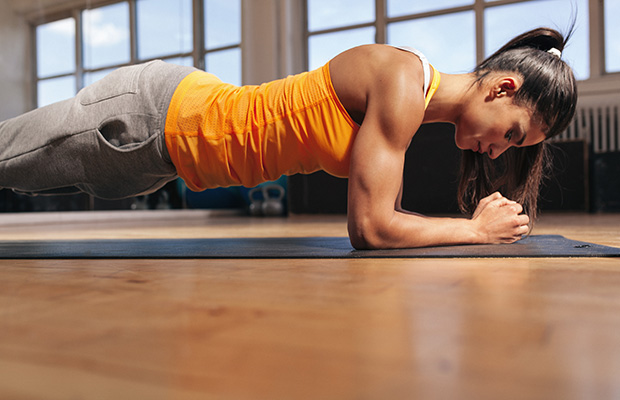
No matter how healthy and fit you are, there’s one part of the body that can get irritated during all kinds of different workouts; ones that use just bodyweight moves as well as kettlebell and barbell workouts alike: the wrist. “Most people complain of wrist pain when they are doing exercises on their hands using their bodyweight — like push-ups, planks and flow movements like bear crawls,” says Lauren Williams, a head coach at Tone House in New York City.
RELATED: You Got a Running Injury During Race Training…Now What?
But don’t worry just yet: You can find wrist relief without cutting any of your favorite exercises from your routine. In an instant, you can switch the tools you’re using, your position, or your base of support — like elevating your hands during push-ups — to minimize the pressure off your joints, says Williams. We took a look at six of the most commonly complained about moves (hey, kettlebell swings!) and asked Williams to share modifications for each exercise. Get ready: You’re about to take a serious load off! (Note: If you’re dealing with a chronic or acute injury, always seek advice from a medical professional first.)
6 Ways to Reduce Wrist Pain During Workouts
1. The Move: Straight-Arm Plank
How to Modify It: “Holding a basic plank can be difficult when you’re dealing with wrist pain,” says Williams. To maintain the position for more than a few seconds without crumbling under the pressure, she suggests doing an elevated plank instead. “By raising your hands to a bench, plyo box, or even TRX bands [for support], you lessen the amount of body weight on your hands and wrists,” says Williams. A second option is to shift down to a forearm plank. You’ll still fire up your core and glutes, but using your arms as a bigger base of support will be more comfortable for you.
RELATED: No Pain, No Gain? 5 Myths About Muscle Soreness
2. The Move: Push-Up
How to Modify It: If planks wreak havoc on your wrists, you likely have the same issue with regular push-ups because they put your hands in the same position and place your body weight on the wrists. Instead, try changing how you position your hands, says Williams. Rather than placing palms flat on the floor, position a dumbbell under each shoulder and grasp the handles with your palms facing each other. This will alleviate pressure on your wrists because it keeps your wrists straight. (Pro tip: If this variation feels uncomfortable for your palms, add a small towel for a little extra padding.) Another option: Do a regular push-up with your hands elevated, exactly like the plank modification above.
3. The Move: Front Squat
How to Modify It: “Doing a front squat with a barbell definitely challenges wrist mobility and can be uncomfortable,” says Williams. A better bet? The goblet squat. Rather than holding a barbell in front of your shoulders, hold a kettlebell or dumbbell (turned up on its side, perpendicular to floor) at chest height in front of your body, then squat normally. Alternatively, you can also try back squats with the barbell on your shoulders behind your head. Or hey, just bodyweight squats with no extra baggage at all.
4. The Move: Pull-Up
How to Modify It: Doing a pull-up with all of your weight can strain your hands and wrists, especially if you’re just getting started with the exercise. Williams recommends lessening the load by stepping one foot into a resistance band before you grab onto the bar and get into pull-up position. Doing so will support some of your weight and take some pressure off your hands. Another option: Try a lat pull-down instead, which targets the same muscles as a pull-up, but reduces strain because you’re sitting.
RELATED: 7 Ways to Prevent Shoulder Pain and Injury
5. The Move: Kettlebell Press
How to Modify It: “I most commonly hear people complaining of wrist pain when training with kettlebells, especially in the rack and overhead positions,” notes Williams. Her solution? Simply wrap a hand towel around your wrists or around the kettlebell itself to create a buffer and release some of the pressure off your joints. If you’re still feeling signs of discomfort, it’s always best to go lighter versus aggravating it more.
6. The Move: Burpee
How to Modify It: “This is a great exercise but can be difficult to perform if you’re having wrist pain due to the impact,” says Williams. An easy way to modify this exercise, she says, it to use a bench. Place your hands on it as you jump back into the push-up portion of the move. By keeping your upper body elevated, you’ll reduce the pressure on your palms and thus on your wrists, too.
Whatever exercises you do, Williams recommends starting and finishing every workout with wrist-mobility drills, like flexing hands up and down repeatedly and rolling fists in circles each way. And if pain persists, make sure to cease exercising and see your doctor.
Not a Daily Burn member? Sign up at dailyburn.com and start your free 30-day trial today.
